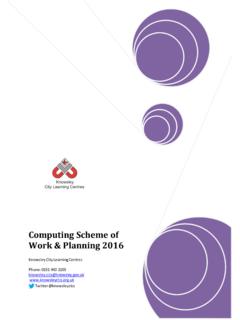Transcription of D2.2 - eCall systems functionalities’ specification
1 19/04/2013 Grant agreement no.: 325075 Pilot type A co-funded by the European Union under the Competitiveness and Innovation Programme ICT Policy Support Programme DG Communications Networks, Content and Technology - eCall systems functionalities specification Version number: Version Main author: Frank Brennecke Dissemination level: PU Lead contractor: ERTICO ITS Europe Due date: 31 March 2013 Delivery date: 19 April 2013 Delivery date updated document - eCall systems functionalities specification 19/04/2013 3 Version Control sheet Version history Version Date Main author Summary of changes Frank Brennecke Draft of the structure Frank Brennecke Adding input Nora Brodersen Reviewing, re-formatting and spell-checking input Frank Brennecke Adding input Frank Brennecke Adding reviews Andy Rooke Minor Corrections Name Date Prepared Frank Brennecke Reviewed Andy Rooke 19 April 2013 Reviewed Authorized Andy Rooke 19 April 2013 Circulation Recipient Date of submission Project partners 19 April 2013 European Commission 19 April 2013 - eCall systems functionalities specification 19/04/2013 4 Version TABLE OF CONTENTS 1 MANAGEMENT SUMMARY.
2 6 2 TERMS AND ABBREVIATIONS .. 7 TERMS .. 7 ABBREVIATIONS .. 10 3 INTRODUCTION .. 13 PURPOSE OF 13 STRUCTURE OF DOCUMENT .. 13 HEERO CONTRACTUAL REFERENCES .. 14 4 LIST OF STANDARDS .. 16 5 FUNCTIONAL ARCHITECTURE AND specification FOR EACH PILOT 17 BELGIUM .. 17 BULGARIA .. 20 DENMARK .. 24 eCall FUNCTION OVERVIEW .. 24 PSAP SUPPORT OF eCall .. 25 LUXEMBOURG .. 26 SPAIN .. 34 eCall CHAIN .. 35 112 SUPPORT OF eCall .. 43 GREECE .. 45 PSAP FUNCTIONS .. 45 NETWORK FUNCTIONS .. 48 TURKEY .. 51 INTRODUCTION .. 51 eCall FUNCTIONS OVERVIEW .. 51 PSAP SUPPORT OF eCall .. 52 NETWORK FUNCTIONS .. 53 IN VEHICLE SYSTEM FUNCTIONS .. 53 6 LITERATURE .. 53 - eCall systems functionalities specification 19/04/2013 5 Version Figures FIGURE 1: STRUCTURE OF DELIVERABLES 13 FIGURE 2: eCall DATA FLOW BELGIUM 17 FIGURE 3: TECHNICAL SCHEME 19 FIGURE 4: eCall ARCHITECTURE 20 FIGURE 5: PSAP eCall DISPATCHING 22 FIGURE 6: HIGH-LEVEL eCall HANDLING PROCESS 22 FIGURE 7: LUXEMBOURG ARCHITECTURE 26 FIGURE 8: eCall DATA FLOW (TAKEN FROM THE GERMAN specification ) 28 FIGURE 9: LUXEMBOURG eCall PSAP ARCHITECTURE 28 FIGURE 10: THE HANDLING OF DANGEROUS GOODS IN LUXEMBURG S eCall 32 FIGURE 11: THE HANDLING OF CROSS-BORDER ISSUES IN LUXEMBURG S eCall 33 FIGURE 12: PSAP RESPONSIBILITIES 35 FIGURE 13: PROPOSED ARCHITECTURE TO HANDLE eCall MESSAGES IN SPANISH PILOT 35 FIGURE 14: P2W eCall DEVICE 37 FIGURE 15: MNO NETWORK PROCESS 38 FIGURE 16: OPERATIONAL STEPS OF PSAP OPERATORS 41 FIGURE 17: ADDITIONAL INTERMEDIATE PSAP FUNCTIONS.
3 TRAFFIC INCIDENT MANAGEMENT PROCEDURES 43 FIGURE 18: PSAP DISPATCHING PROCESS 44 FIGURE 19: DIAGRAM OF UPGRADED PSAP TO SUPPORT eCall 45 FIGURE 20: eCall HANDLING PROCEDURE 47 FIGURE 21: eCall ROUTING 49 FIGURE 22: eCall FLOW SCHEMA 52 Tables TABLE 1: PARTICIPANTS IN eCall CHAIN 36 TABLE 2: EXECUTE TRAFFIC INCIDENT MANAGEMENT PROCEDURES 42 TABLE 3: TS12 DESCRIPTION 48 TABLE 4: EMERGENCY SERVICE CATEGORY BITS 49 - eCall systems functionalities specification 19/04/2013 6 Version 1 Management Summary Road fatalities in the EU-27 have fallen by 43% between 2010 and 2001, when the European Commission published its White Paper on European Transport Policy. The European Road Safety Action Programme and the Intelligent Car Initiative have had a significant impact on this positive development, and are expected to continue in the medium term to produce further benefits towards the vision of zero road fatalities. However, with around million serious traffic collisions causing around 31 000 deaths and more than million injured in 2010 on European roads, for an estimated cost to the society of about EUR 160 billion, further action is required.
4 The pan-European in-vehicle emergency call, eCall , is estimated to have the potential to save up to 2 500 fatalities annually in EU-27 when fully deployed, to reduce the severity of injuries, bring significant savings to society in healthcare and other costs and reduce human suffering. The HeERO2 project will prepare, carry-out and coordinate eCall pre-deployment pilots at European level taking into account the approved standards. The overall project objective is to prepare for the deployment of the necessary infrastructure in Europe with the aim of making the Pan-European in-vehicle emergency call service eCall a reality. The implementation of the in-vehicle emergency call service eCall at European level should take into account two major conditions on which its successful operations will depend: a) Interoperability and cross border continuity: the possibility for any vehicle from any European country travelling across Europe to use the eCall service in case of a serious collision should be a service key driver.
5 The interoperability issue covers not only the technical solution but also operations aspect. b) Harmonisation: the eCall service can work properly across Europe only if developed in a harmonised way in the different countries, still respecting the different national implementations. The use of 112/E112 represents the first steps of this harmonised approach. HeERO2 phase 1 has issued an exhaustive state-of-the-art analysis in the area of 112 resp. E112 calls identifying all necessary system implementation steps with a focus on: - eCall systems functionalities specification 19/04/2013 7 Version in-vehicle system equipment interface telecommunication infrastructure (specifically 112/E112 related parts) PSAP infrastructure This analysis issued the Hardware (HW) and Software (SW) set-ups needed at different HeERO Phase 1 pilot sites and gathered the initial background information for the definition of steps leading towards the eCall standards implementation.
6 On this basis, the In Vehicle System, 112/E112 and PSAPs needed upgrades have been defined for HeERO Phase 1 member states. Based on this analysis, this document describes how PSAPs will operate in the Member States after eCall systems has been installed. 2 Terms and abbreviations Terms TERM DEFINITION 112 single European emergency call number supporting Teleservice 12 (ETSI TS 122 003) call clear-down termination of call and freeing up of line (usually achieved by hanging up the receiver or pressing end call or similar on screen) cellular network wireless communications network consisting of multiple adjacent access points (cells) with the capability of homogeneous transfer of a communications session instance to an adjacent cell without significant interruption to the session CSC Customer Service Centre E112 emergency communications service using the single European emergency call number, 112, which is enhanced with location information of the calling user TS12 eCall emergency call generated either automatically via activation of in-vehicle sensors or manually by the vehicle occupants.
7 When activated it provides notification and relevant location information to the most appropriate Public Safety Answering Point, by means of mobile wireless communications networks, carries a defined standardized minimum set of - eCall systems functionalities specification 19/04/2013 8 Version data (MSD) notifying that there has been an incident that requires response from the emergency services, and establishes an audio channel between the occupants of the vehicle and the most appropriate Public Safety Answering Point eCall generator occupant of a vehicle or equipment within a vehicle that has cause to trigger an eCall transaction by automatic or manual means eCall discriminator or identifier one of two information element bits (flags) included in the emergency call set-up message that may be used by the mobile network to filter and route automatically and manually initiated eCall to a designated PSAP eCall In-band Modem (eIM) Modem pair (consisting of transmitters and receivers at IVS and PSAP) that operates full-duplex and allows reliable transmission of eCall Minimum Set of Data from IVS to PSAP via the voice channel of the emergency voice call through cellular and PSTN networks.
8 eCall service end-to-end emergency service to connect occupants of an affected vehicle to the most appropriate PSAP via an audio link across a PLMN together with the transfer of a minimum set of data to the PSAP eCall transaction establishment of a mobile wireless communications session across a public wireless communications network and the transmission of a minimum set of data from a vehicle to a public safety answering point and the establishment of an audio channel between the vehicle and the PSAP eCall trigger signal emanating from within the vehicle to the eCall in-vehicle equipment which requests to start an eCall transaction eIP eCall Implementation Platform emergency control centre unit which deals with emergency calls and which has the capacity to consider professionally the need for response, and which has the provision to mobilize the needed resources to deal with the emergency in question eSafety European Commission-sponsored forum to improve safety for European citizens in-vehicle equipment equipment within the vehicle that provides or has access to in-vehicle data required for the minimum set of data and any other data that is to be sent as part of or complementary to the minimum set of data to effect the eCall transaction via a public mobile wireless communications network providing a link between the vehicle and a means of enacting the eCall - eCall systems functionalities specification 19/04/2013 9 Version service via a public mobile wireless communications network in-vehicle system (IVS) in-vehicle equipment together with the means to trigger, manage and effect the eCall transaction Minimum Set of Data (MSD)
9 Standardized data concept comprising data elements of relevant vehicle generated data essential for the performance of the eCall service [EN 15722:2011] most appropriate PSAP PSAP defined beforehand by responsible authorities to cover emergency calls from a certain area or for emergency calls of a certain type network access device (NAD) device providing communications to a mobile wireless communications network with homogeneous handover between network access points public safety answering point (PSAP) physical location working on behalf of the national authorities where emergency calls are first received under the responsibility of a public authority or a private organisation recognised by the national government service provider physical and functional component responsible for providing telematics based services to its subscribers Teleservice 12 emergency service supported by PLMNs TPSP third Party Service Provider TPS- eCall Third Party Services supporting eCall .
10 In these cases, the vehicle dials a private number to contact a call centre, which filters the call and transmits the MSD and the call to the Public Safety Answering Points in case of emergency. vehicle manufacturer entity which first assembles the vehicle and provides eCall equipment as part of its specification and subsequently sells the vehicle directly or via an agent VIN vehicle Identification Number vehicle occupant(s) person(s) inside the vehicle - eCall systems functionalities specification 19/04/2013 10 Version Abbreviations TERM DEFINITION 3G Third generation mobile telecommunication system 3 GPP Third generation partnership protocol ACK Acknowledgement AIeC Automatic Initiated eCall AMR Adaptive_Multi-Rate ARQ Automatic Repeat Request AT Attention (part of modem instruction to dial as specified in ETSI TS 127 007) BCD Binary coded decimal BER Basic encoding rules ( ) BS Bearer Services CAN Controller-Area Network CRC Cyclic Redundancy Check CTM Cellular Text telephony Modem eIM eCall In band Modem ETSI European Telecommunications Standards Institute FEC Forward Error Correction GIS Geographic Information System GMSK Gaussian minimum shift keying (modulation) GNSS Global Navigation Satellite System GSM Global System for Mobile communications HGV Heavy Goods Vehicle HLR Home Location Registry HMI Human Machine Interface HPLMN Home Public Land Mobile Network IAM Immediate Alert Message - eCall systems functionalities specification 19/04/2013 11 Version IMEI International Mobile Equipment Identity IMSI International Mobile Subscriber Identity IND Indication IVS In-Vehicle System LAN Local Area Network LTE Long Term Evolution (of 3G UMTS access network) MIeC Manually Initiated eCall MSC Mobile Switching Centre MNO Mobile Network Operator MSISDN Mobile Subscriber ISDN (integrated services digital network)






